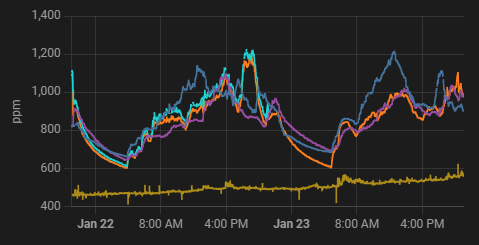I’m also curious about @ichiban’s question/issue “After establishing this baseline, it makes no sense to me that the baseline should periodically get updated with a 1 week trailing low.”
Can someone at AG or someone with more knowledge about the sensor explain why re-calibrating against a 1 week trailing low is the best default? For example, does post-calibration drift occur so fast that, if it was calibrated much less frequently (say, once a year), it would be inaccurate?
Stated another way, could it use the lowest value in the last 3 months instead of the lowest in the last 1 week (if it can stay calibrated for 3 months), or only calibrate when explicitly requested? I don’t know enough about the typical usage to propose the sanest default, so please take my comments with a grain of salt. That said, 1 week seems like a fairly short lookback period (plenty of rooms have bad airflow, especially in cold winters), and if the sensor can maintain calibration for months, a longer lookback period seems like a better default.
Alternatively, if the longest possible lookback period is 1 week, maybe let users choose the calibration mode based on the property of their room? For example, imagine 2 radio buttons on the sensor settings page:
Does this room receive plenty of outside air at least once a week, all year? Learn more
( ) Yes, my room gets plenty of outside air at least once a week, all year around. Automatically re-calibrate it to the lowest CO2 value seen in the past week.
( ) No, my room is sometimes closed up for a week or more or may have poor circulation. Don’t re-calibrate it automatically.
If the user chooses the second option, disable auto calibration and email the user a reminder once a year or however often it’s needed, or at least show the date of last calibration in red in the Dashboard when it’s past the recommended frequency.

